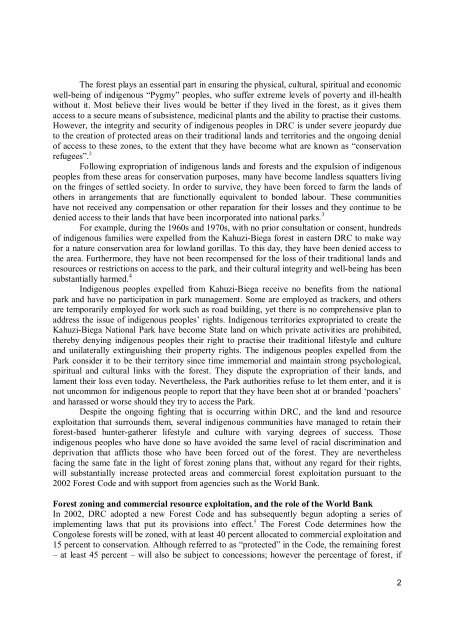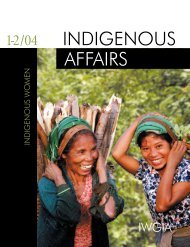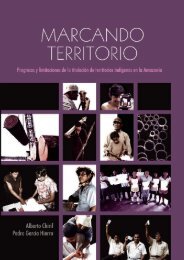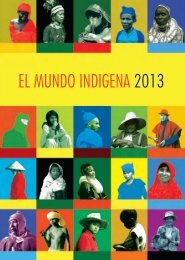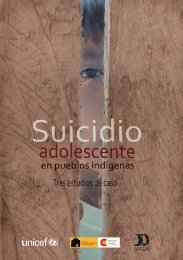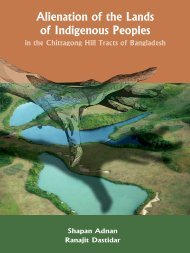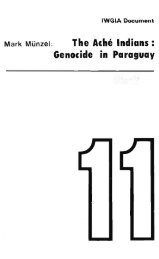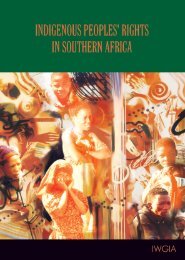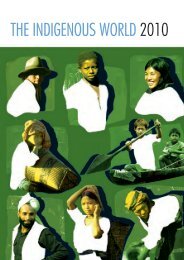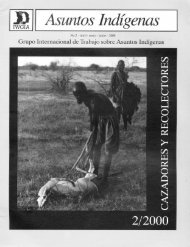Download (pdf) - iwgia
Download (pdf) - iwgia
Download (pdf) - iwgia
Create successful ePaper yourself
Turn your PDF publications into a flip-book with our unique Google optimized e-Paper software.
The forest plays an essential part in ensuring the physical, cultural, spiritual and economicwell-being of indigenous “Pygmy” peoples, who suffer extreme levels of poverty and ill-healthwithout it. Most believe their lives would be better if they lived in the forest, as it gives themaccess to a secure means of subsistence, medicinal plants and the ability to practise their customs.However, the integrity and security of indigenous peoples in DRC is under severe jeopardy dueto the creation of protected areas on their traditional lands and territories and the ongoing denialof access to these zones, to the extent that they have become what are known as “conservationrefugees”. 2Following expropriation of indigenous lands and forests and the expulsion of indigenouspeoples from these areas for conservation purposes, many have become landless squatters livingon the fringes of settled society. In order to survive, they have been forced to farm the lands ofothers in arrangements that are functionally equivalent to bonded labour. These communitieshave not received any compensation or other reparation for their losses and they continue to bedenied access to their lands that have been incorporated into national parks. 3For example, during the 1960s and 1970s, with no prior consultation or consent, hundredsof indigenous families were expelled from the Kahuzi-Biega forest in eastern DRC to make wayfor a nature conservation area for lowland gorillas. To this day, they have been denied access tothe area. Furthermore, they have not been recompensed for the loss of their traditional lands andresources or restrictions on access to the park, and their cultural integrity and well-being has beensubstantially harmed. 4Indigenous peoples expelled from Kahuzi-Biega receive no benefits from the nationalpark and have no participation in park management. Some are employed as trackers, and othersare temporarily employed for work such as road building, yet there is no comprehensive plan toaddress the issue of indigenous peoples’ rights. Indigenous territories expropriated to create theKahuzi-Biega National Park have become State land on which private activities are prohibited,thereby denying indigenous peoples their right to practise their traditional lifestyle and cultureand unilaterally extinguishing their property rights. The indigenous peoples expelled from thePark consider it to be their territory since time immemorial and maintain strong psychological,spiritual and cultural links with the forest. They dispute the expropriation of their lands, andlament their loss even today. Nevertheless, the Park authorities refuse to let them enter, and it isnot uncommon for indigenous people to report that they have been shot at or branded ‘poachers’and harassed or worse should they try to access the Park.Despite the ongoing fighting that is occurring within DRC, and the land and resourceexploitation that surrounds them, several indigenous communities have managed to retain theirforest-based hunter-gatherer lifestyle and culture with varying degrees of success. Thoseindigenous peoples who have done so have avoided the same level of racial discrimination anddeprivation that afflicts those who have been forced out of the forest. They are neverthelessfacing the same fate in the light of forest zoning plans that, without any regard for their rights,will substantially increase protected areas and commercial forest exploitation pursuant to the2002 Forest Code and with support from agencies such as the World Bank.Forest zoning and commercial resource exploitation, and the role of the World BankIn 2002, DRC adopted a new Forest Code and has subsequently begun adopting a series ofimplementing laws that put its provisions into effect. 5 The Forest Code determines how theCongolese forests will be zoned, with at least 40 percent allocated to commercial exploitation and15 percent to conservation. Although referred to as “protected” in the Code, the remaining forest– at least 45 percent – will also be subject to concessions; however the percentage of forest, if2


